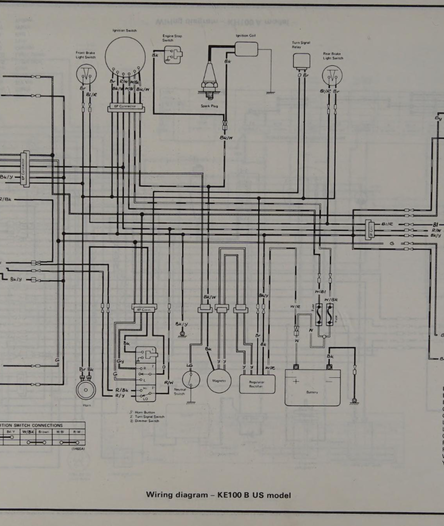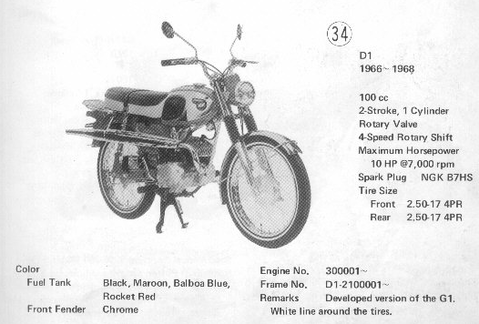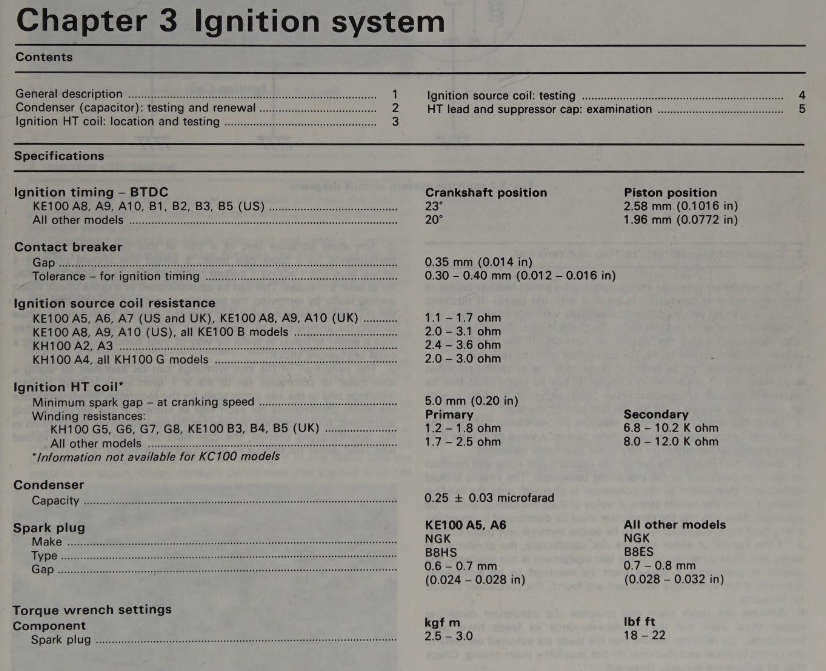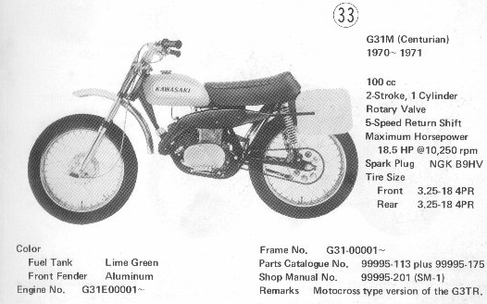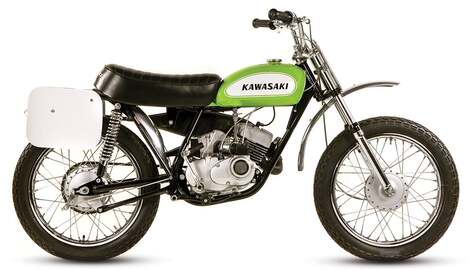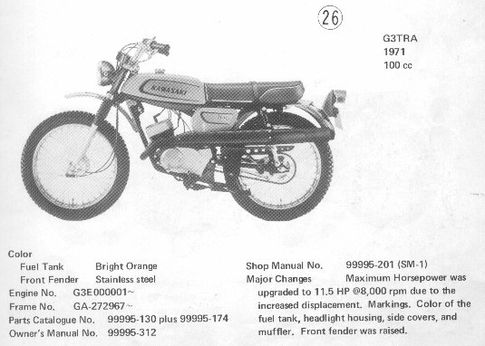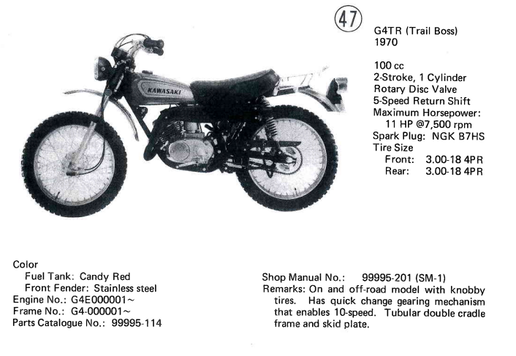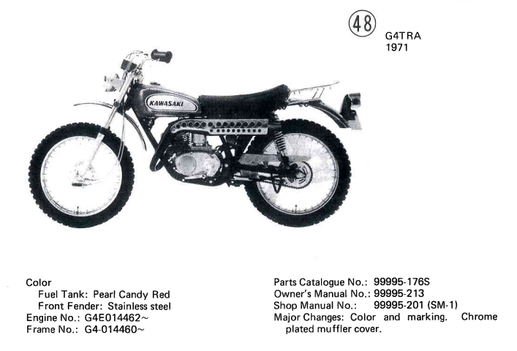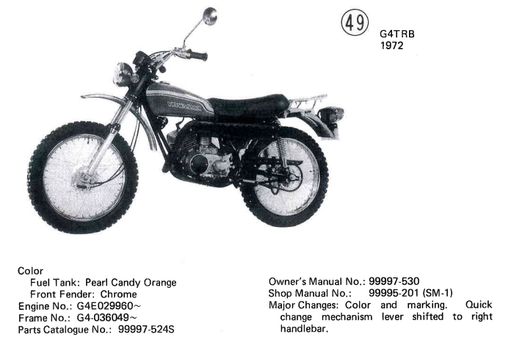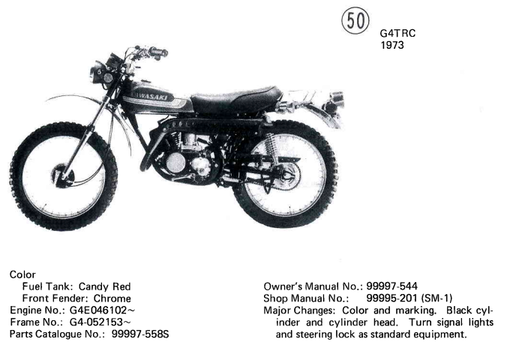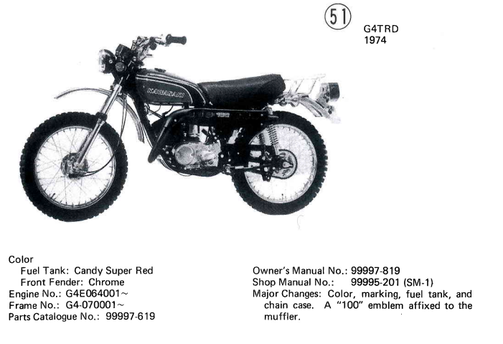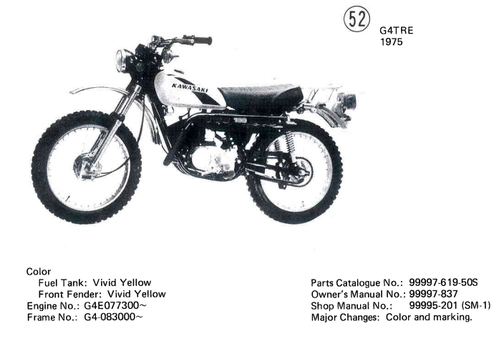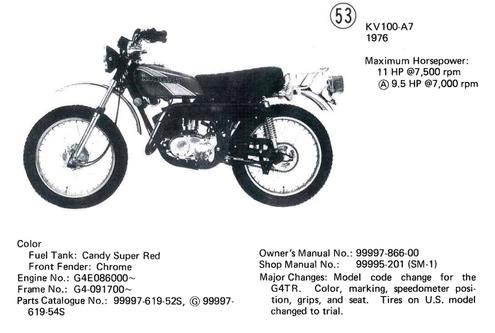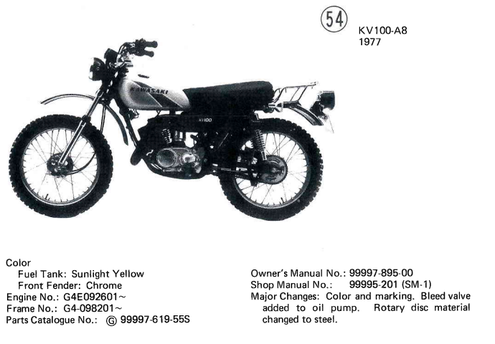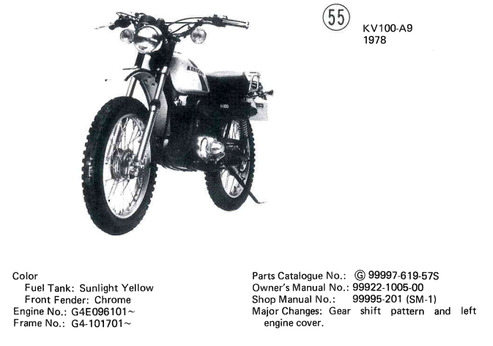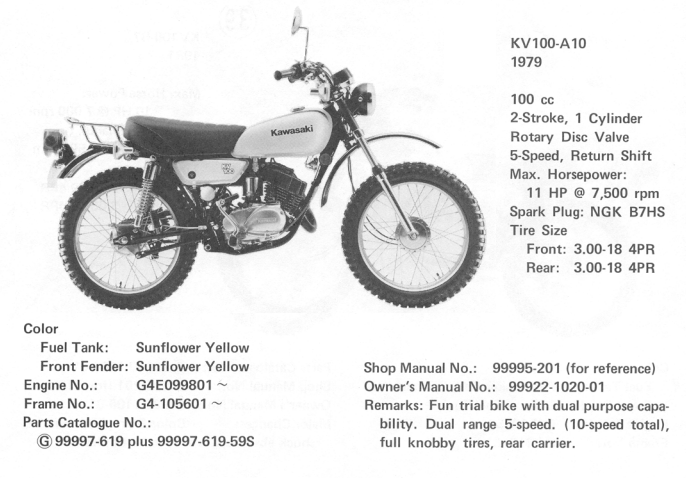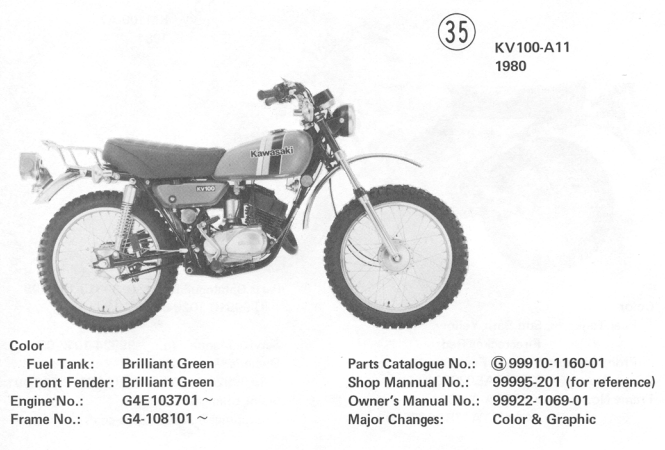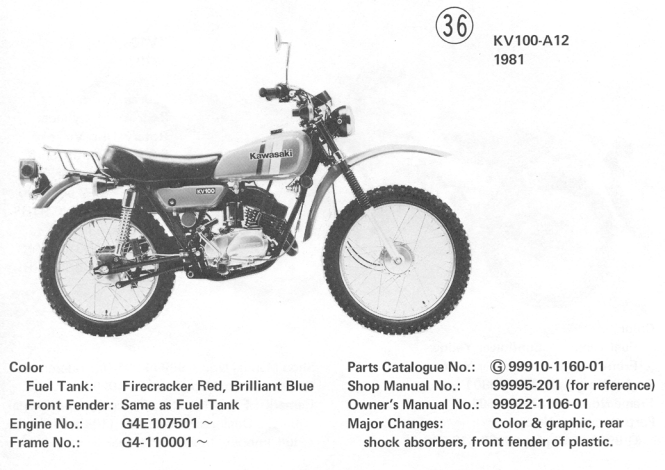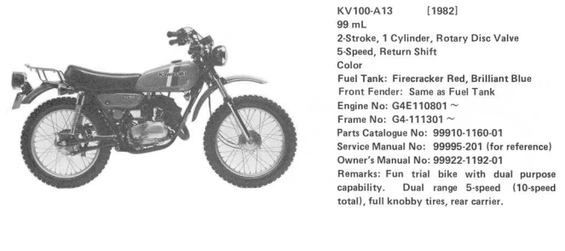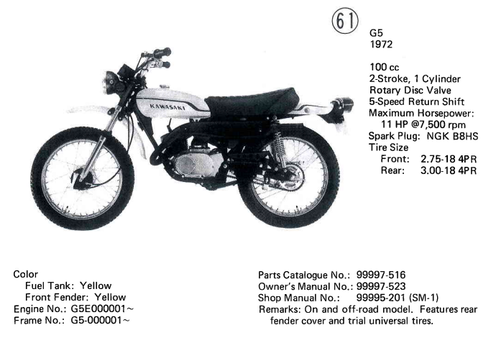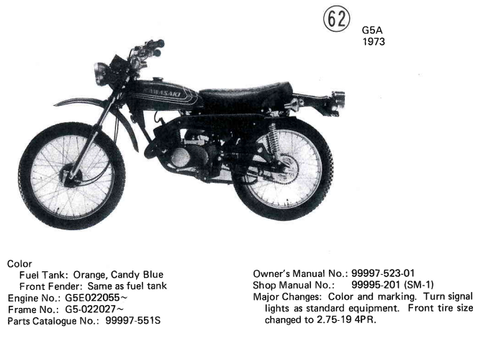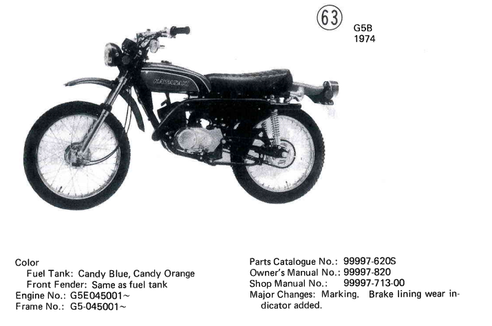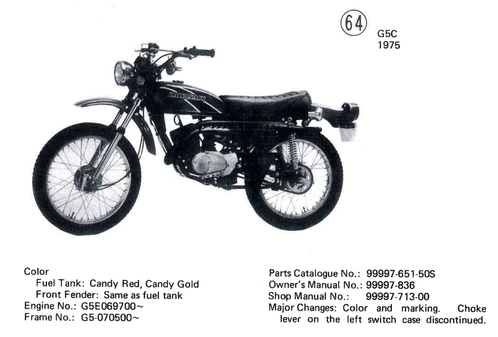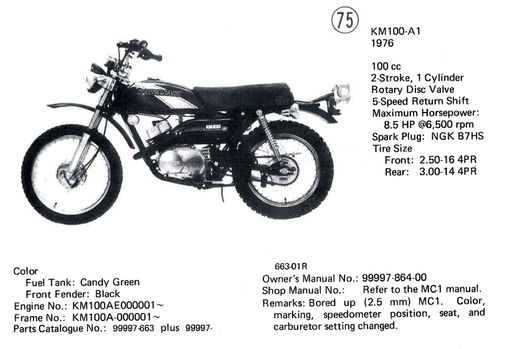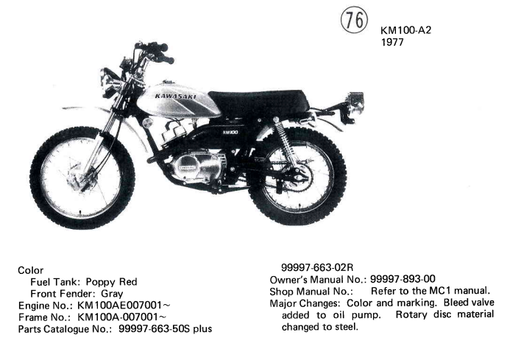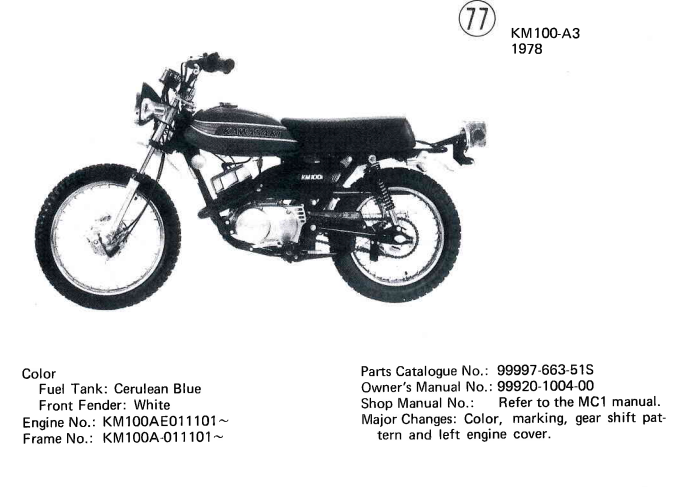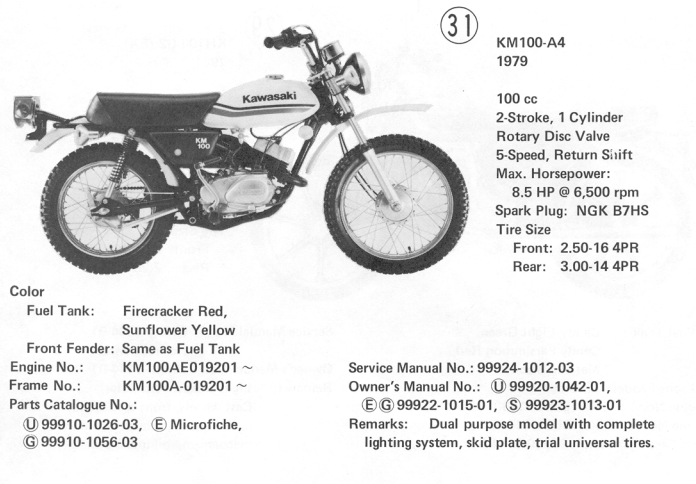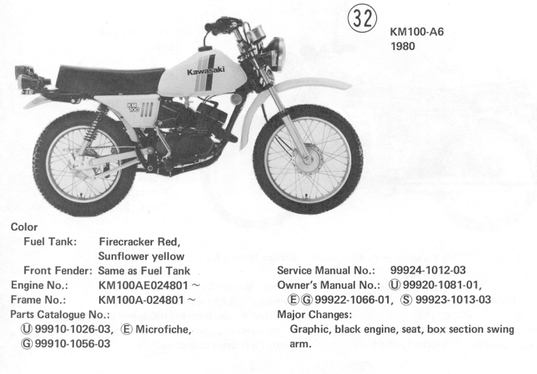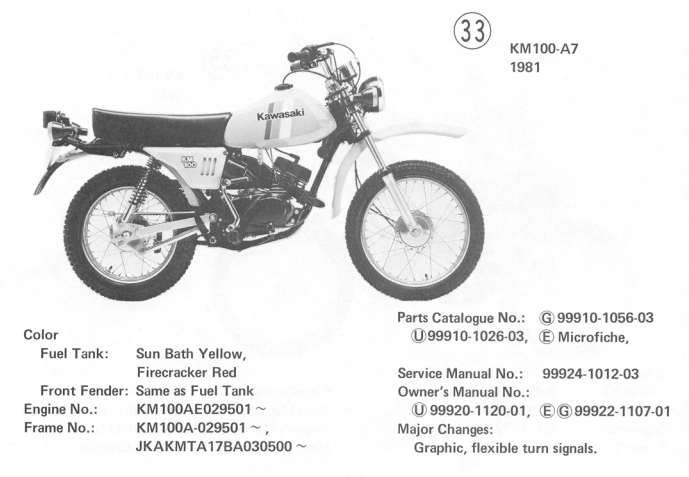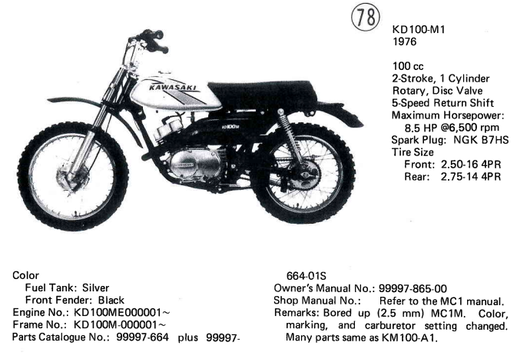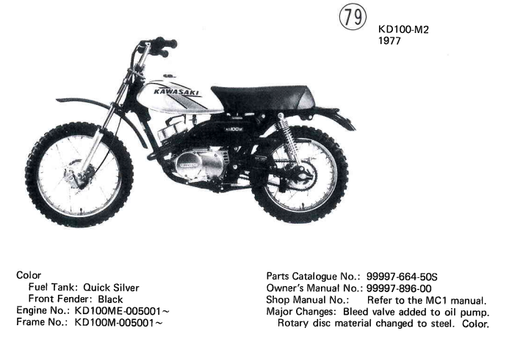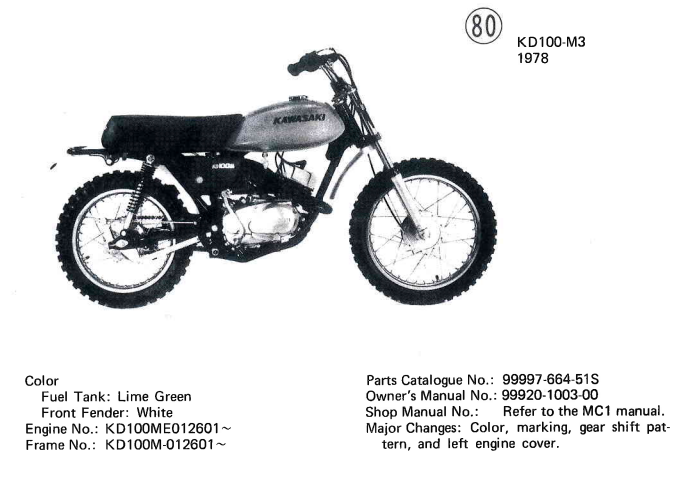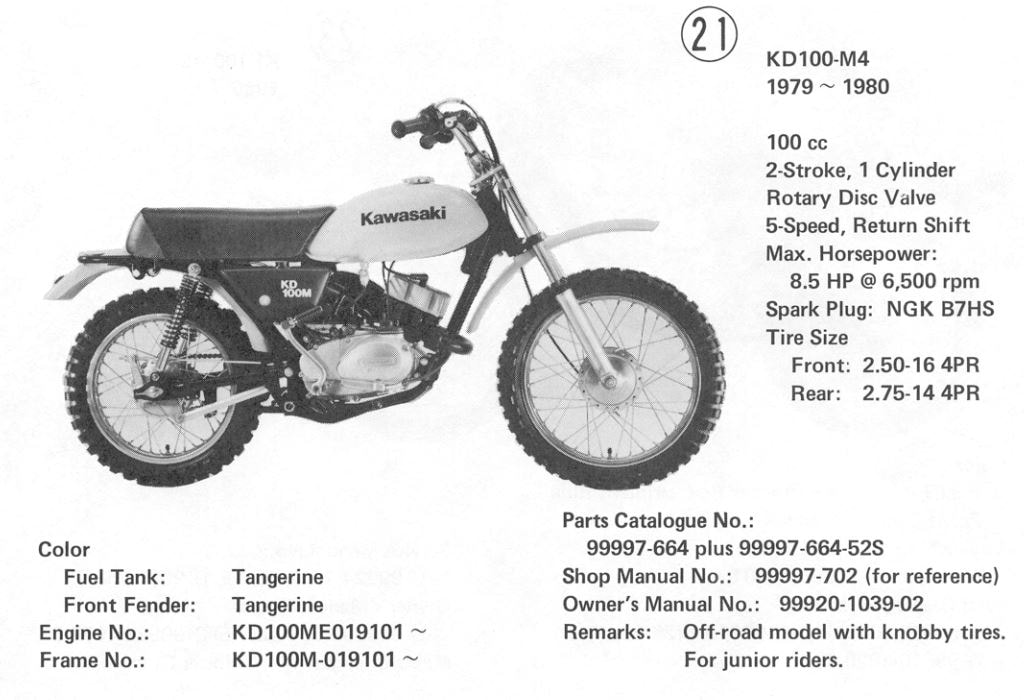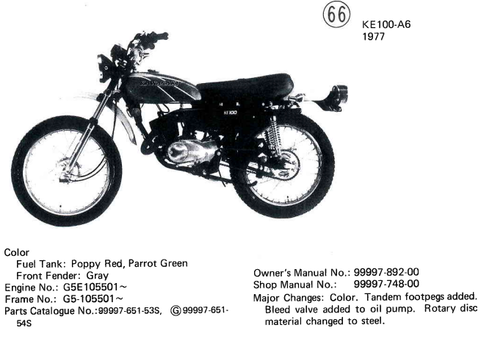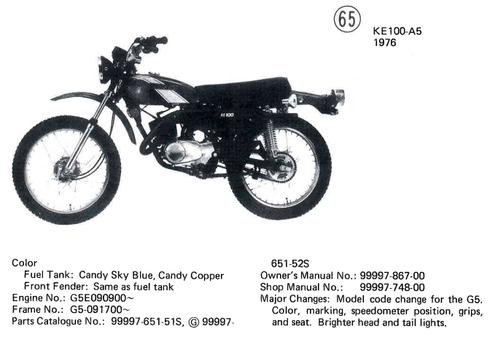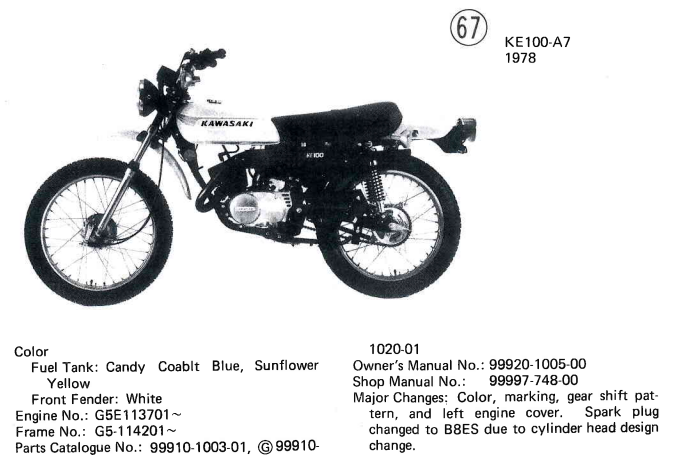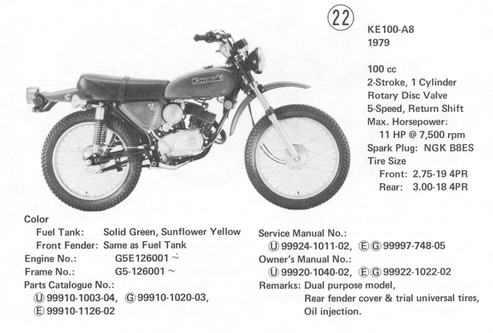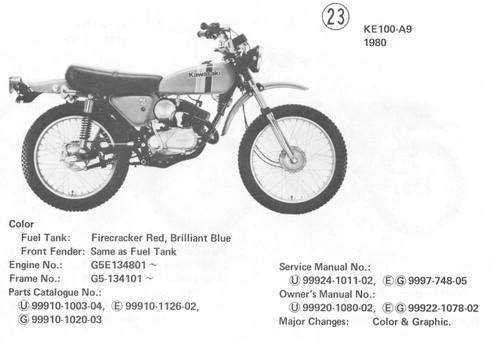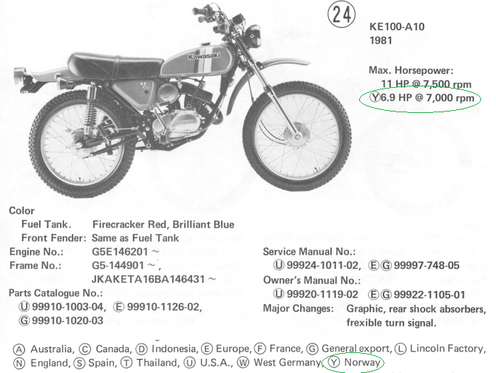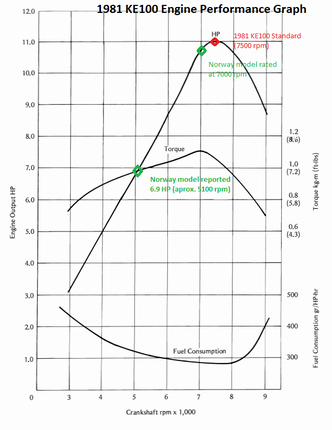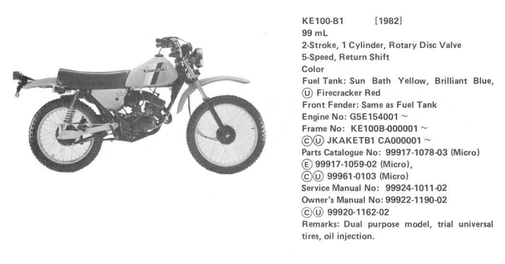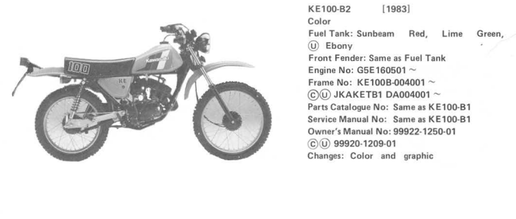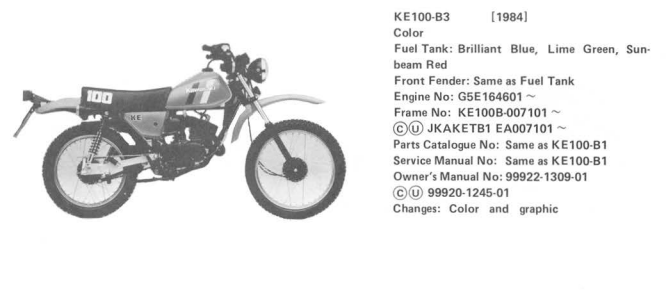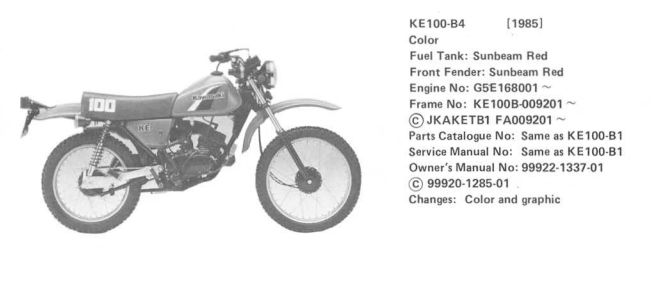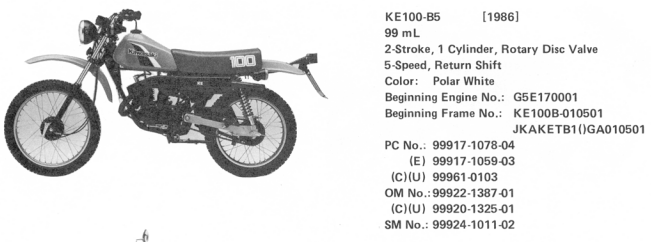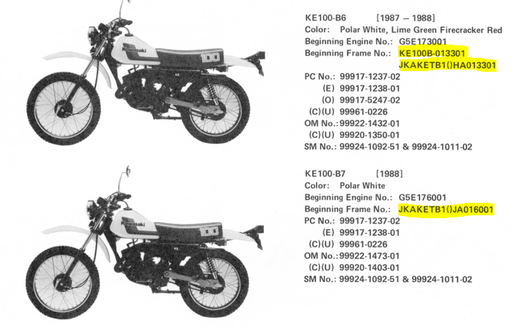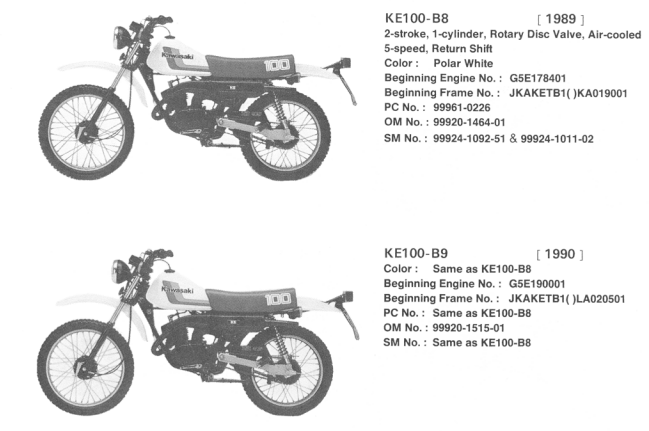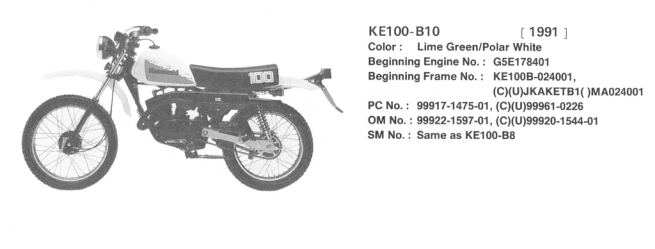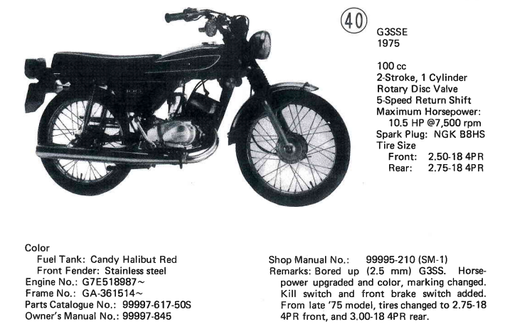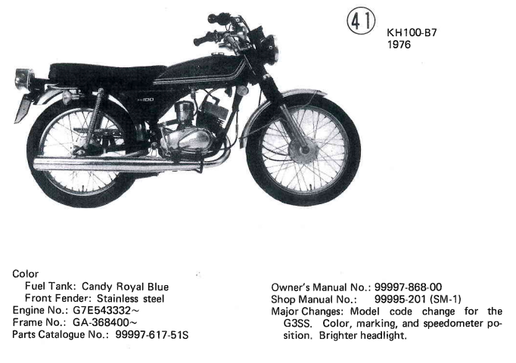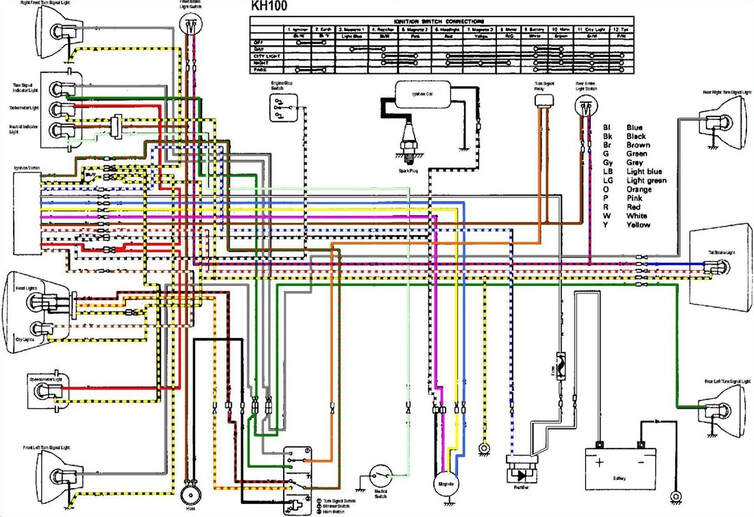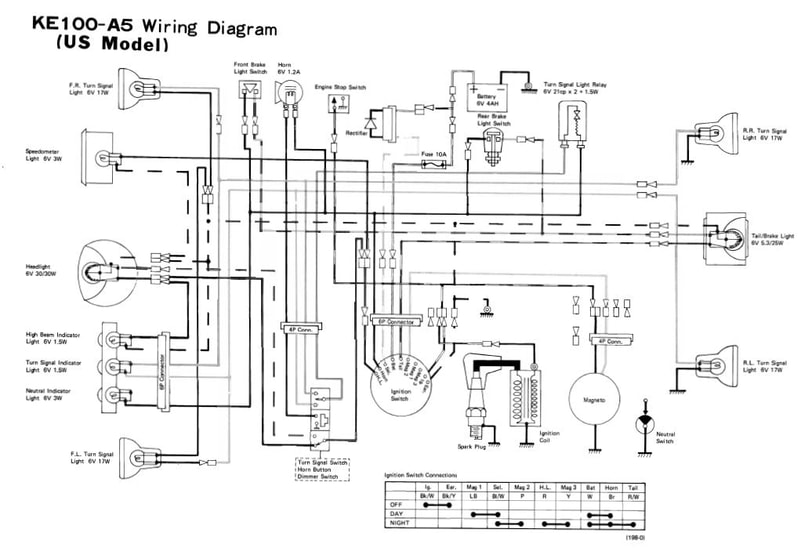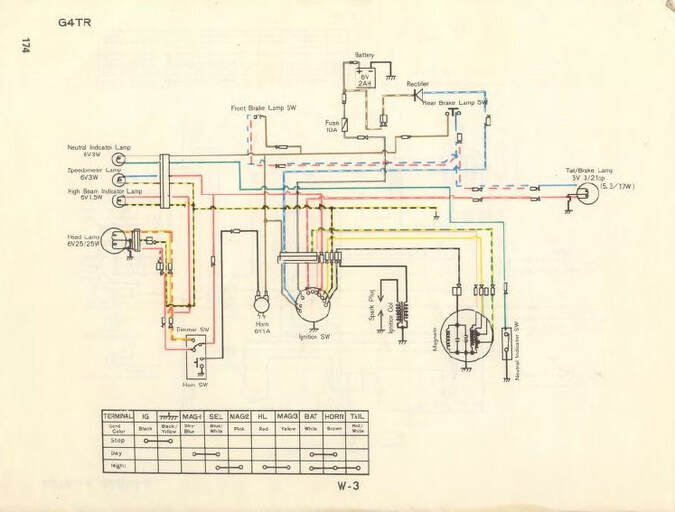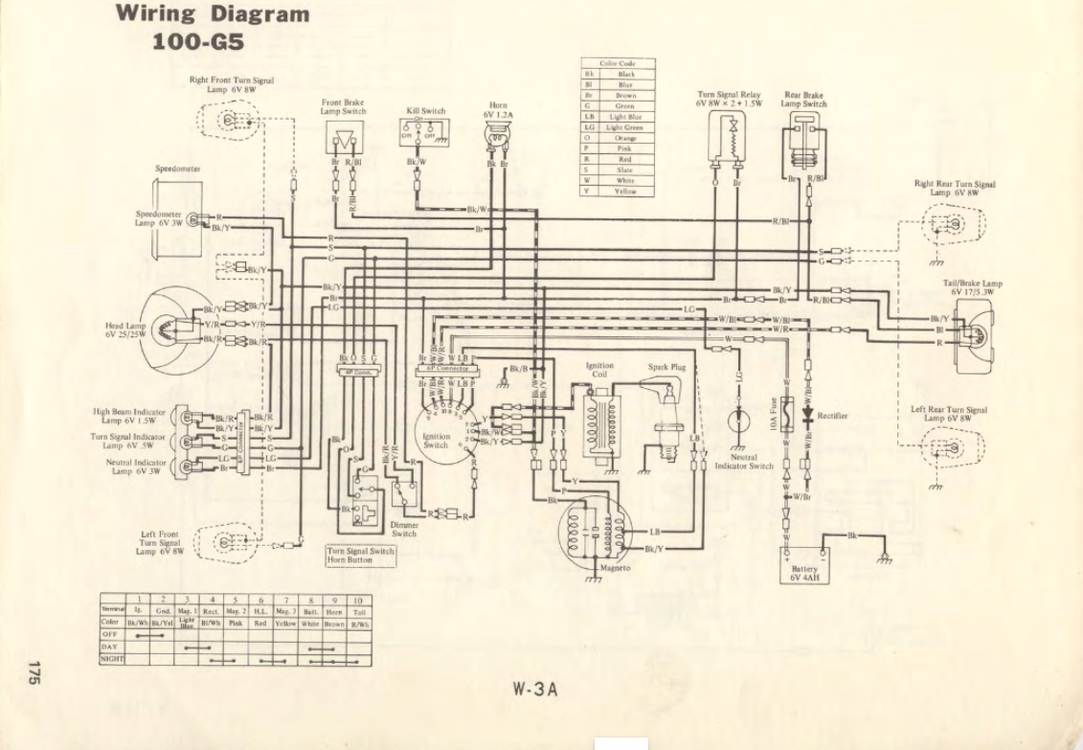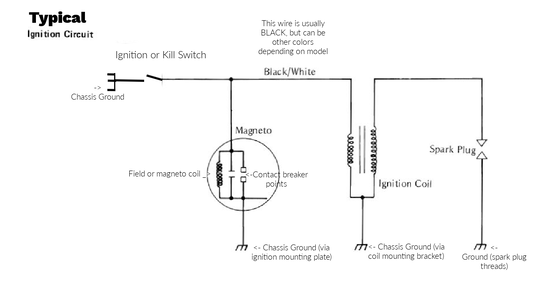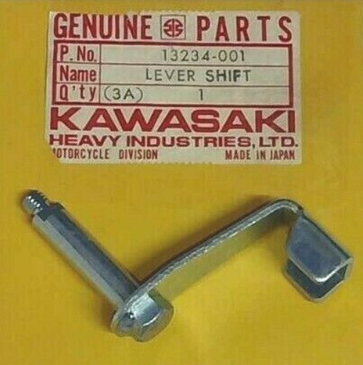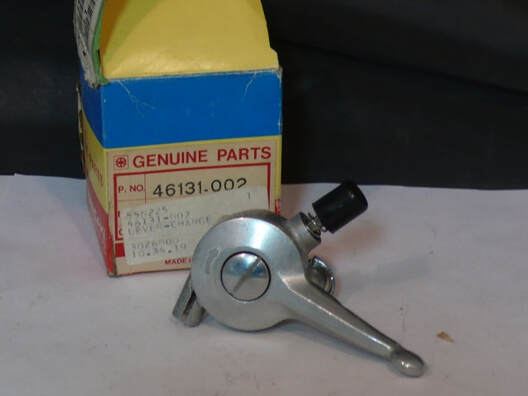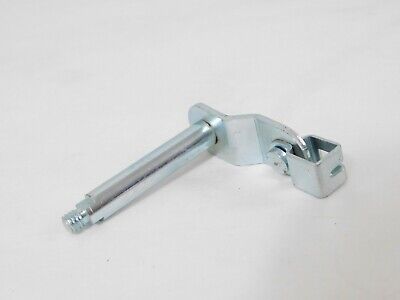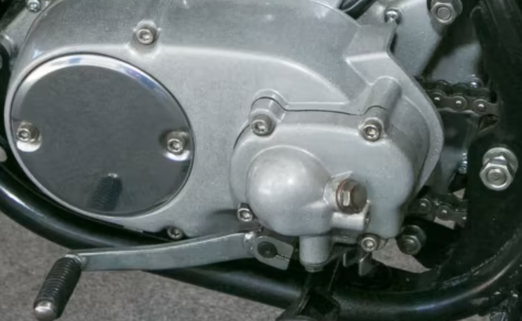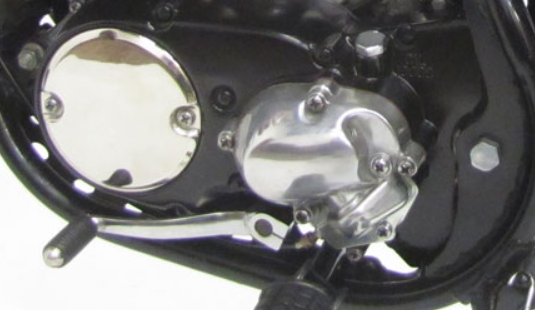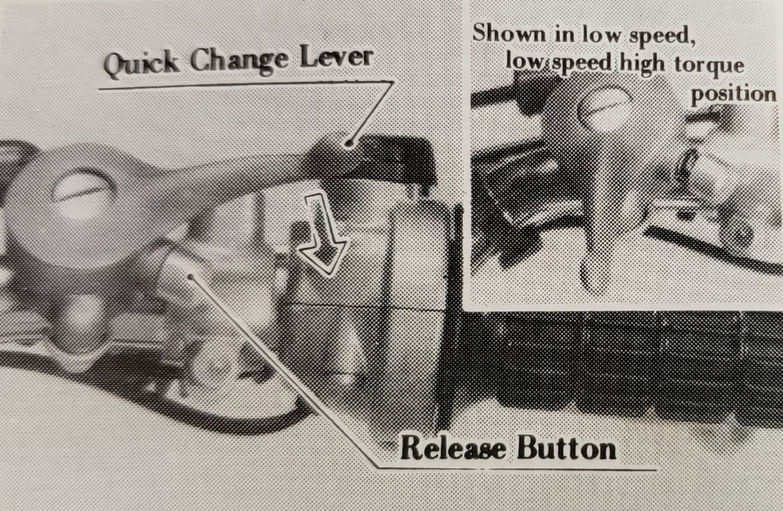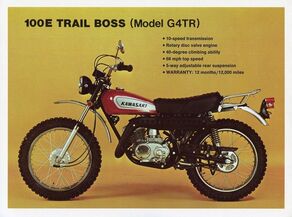 Kawasaki G4TR
Kawasaki G4TR
100 CC
D1, G3SS, G3TRA, G4TR (Trail Boss), G5, KE100, KV100, KM100, KD100, KH100, G31M (Centurion)
See 125cc section for 120cc C1, C1L, C1D, C1DL, C2TR models
All the 100cc engines, generally speaking, share a lot of internal and external parts. Later models that superseded earlier models usually have some subtle changes to either improve performance OR durability. Some of these 100cc models also are very closely related to some of the 90cc models. Some of the 100cc models share lower end and engine covers with the 90cc models. Some models simply fitted a larger piston and cylinder to create a new model. Early models used a transmission shift pattern of N-1-2-3-4-5. Starting in 1978 models would have their shift drum changed for a more standard 1-N-2-3-4-5 shift pattern. Early bikes have rotary shift patterns (N-1-2-3-4-5-N...) while later bikes have a return shift pattern (N-1-2-3-4-5 or 1-N-2-3-4-5). See specific detail notes below for each model & year. When researching parts it is within these subtleties of specifications where certain models can be harder to find specific parts over more broader models. Some models like the G4TR & KV100 feature the unique "dual range" transmission
Go here for specific information on the Australian only models the G4TR Agri (Agi) and KV100-B series bikes. These were specifically targeted to the large agricultural farms in Australia.
120cc C-Series bikes can be found on the 125cc page
D1, G3SS, G3TRA, G4TR (Trail Boss), G5, KE100, KV100, KM100, KD100, KH100, G31M (Centurion)
See 125cc section for 120cc C1, C1L, C1D, C1DL, C2TR models
All the 100cc engines, generally speaking, share a lot of internal and external parts. Later models that superseded earlier models usually have some subtle changes to either improve performance OR durability. Some of these 100cc models also are very closely related to some of the 90cc models. Some of the 100cc models share lower end and engine covers with the 90cc models. Some models simply fitted a larger piston and cylinder to create a new model. Early models used a transmission shift pattern of N-1-2-3-4-5. Starting in 1978 models would have their shift drum changed for a more standard 1-N-2-3-4-5 shift pattern. Early bikes have rotary shift patterns (N-1-2-3-4-5-N...) while later bikes have a return shift pattern (N-1-2-3-4-5 or 1-N-2-3-4-5). See specific detail notes below for each model & year. When researching parts it is within these subtleties of specifications where certain models can be harder to find specific parts over more broader models. Some models like the G4TR & KV100 feature the unique "dual range" transmission
Go here for specific information on the Australian only models the G4TR Agri (Agi) and KV100-B series bikes. These were specifically targeted to the large agricultural farms in Australia.
120cc C-Series bikes can be found on the 125cc page
|
KE100 Ignition source coil (magneto) resistance
KE100 A5-A10: 1.1-1.7 ohm KE100 B models: 2.0-3.1 ohm KH100 A2, A3: 2.4-3.6 ohm KH100 A4, all G models: 2.0-3.0 ohm D1 1966-1968
*100cc version of the G1 (90cc) Engine No. 300001- Frame No. D1-2100001- Increased horsepower over the previous G1 (90cc) model. Horsepower up from 8.2 to 10. Sold right along side the G1 model. This can cause confusion when identifying each model. One of the last models to use a rotary shift pattern. Oiling system: incorporated (then new) Kawasaki's Super-Lube Ignition: Contact Breaker Point Points gap: 0.3mm~0.4mm ALL Models Transmission oil: SAE 30W |
|
G31M (Centurion) 1970-1971
*motocross version of the G3TR (90cc)/C3TRA (100cc) Engine No. G31E00001- Frame No. G31-00001- It should be noted that the G31M Centurion shares very little with the other 100cc bikes, most of the internal parts are unique including the plated cylinder (for reduced friction and heat dissipation), thus giving it the 18.5 hp (claimed) versus all the other 100cc models producing around 11 horsepower. Externally the engine looks very similar to the other G3 bikes. Use engine and frame number to confirm model. One of the standout features is the auxiliary air intake screen cut into the side of the carburetor cover, similar to the F81M (250cc) model that was marketed along side it. Also the exhaust is unique to this model only. Sometimes called the baby Green Streak. Oiling system: Pre-mix only Ignition: Contact Breaker Point Points gap: 0.3mm~0.4mm ALL Models Transmission oil: SAE 30W or ATF |
|
G3TRA 1971
*displacement increased 100cc from 90cc G3TR Engine No. G3E000001- Frame No. GA-272967- Displacement increase to 100cc resulting increased horsepower to 11.5 over the previous G3TR's 10.5. Stylistic changes including raised front fender indicating more "enduro" styling and use. Oiling system: incorporated (then new) Kawasaki's Super-Lube Ignition: Contact Breaker Point Points gap: 0.3mm~0.4mm ALL Models Transmission oil: SAE 30W |
|
G4TR (TrailBoss) 1970
*selectable dual range transmission, "enduro styling" Engine No. G4E000001- Frame No. G4-000001- Knobby tires for more off-road prowess. Dual range transmission selector for Hi-Lo use of its 5 speeds, effectively making it a 10 speed transmission. However it cannot be used "on the fly", the bike must be stationary before changing ranges. Better rear shocks fitted over street only models. (see bottom of page for information about the dual range transmission operation) *Mis-print of the model picture shows the 1971 model for 1970 as evidenced by the tank graphics and black exhaust heat sheild. |
|
G4TRA (TrailBoss) 1971
*updated tank graphics Engine No. G4E014462- Frame No. G4-014460- Only minor stylistic changes. (see bottom of page for information about the dual range transmission operation) *Mis-print of the model picture shows the 1970 model for 1971 as evidenced by the tank graphics and chrome exhaust heat shield. |
|
G4TRB 1972
*minor revisions Engine No. G4E029960- Frame No. G4-036049- Dual range transmission now operated via cable & lever on the right side of the handlebar next to the throttle housing. Slight revision to the Hi-Lo transmission casting. Otherwise only stylistic changes. (see bottom of page) *some very early 1972 models may still have the lever down under the case on by the gear shift lever as a result of left over 1971 parts being used. |
|
G4TRC 1973
*cylinder & head painted black Engine No. G4E046102- Frame No. G4-052153- First year for cylinder & head painted black for heat dissipation otherwise the specifications are identical to earlier years. Left hand engine cover now painted black, with ignition cover remaining chrome. This helps for accurate restorations when searching for parts. |
|
G4TRD 1974
*minor revisions Engine No. G4E064001- Frame No. G4-070001- Left hand engine cover returns to a natural aluminum color from the prior year being painted black. Otherwise only minor styling differences. Exhaust heat shield changed. Starting this year Kawasaki would make a purpose built "farm bike" for the Australian agricultural market known as the "Agi-bike". |
|
G4TRE 1975
*minor styling revisions Engine No. G4E077300- Frame No. G4-083000- No major updates, just styling. Kawasaki would make a purpose built "farm bike" for the Australian agricultural market based off this model. |
|
KV100-A7 1976
*model designation change Engine No. G4E086000- Frame No. G4-091700- Model designation change from G4TR to KV100 to align with other Kawasaki models this year. Minor stylistic revisions, otherwise parts will interchange with G4TR. Australian agricultural market "agi-bikes" would change model designations from G4TR to KV100B series. |
|
KV100-A9 1978
*Gear shift pattern change, minor revisions Engine No.: G4E096101- Frame No.: G4-101701- Gear shift pattern change to 1-N-2-3-4-5 KV100-A10 1979
*styling changes Engine No: G4E099801- Frame No: G4-105601- KV100-A11 1980
*styling changes Engine No: G4E103701- Frame No: G4-108101- KV100-A12 1981
*styling changes Engine No: G4107501- Frame No: G4-110001- KV100-A13 1982
*styling changes, final year Engine No: G4E110801- Frame No: G4-111301- Final year for the G4 based KV100-A model with dual range transmission. This would be superseded by the G5/KE 100cc bikes which do not have the dual range feature. The engine would live on in the "agi bike" KV100-B series for the Australian market. *last year for the dual range transmission |
|
G5 1972
*G4TR series without the dual range transmission Engine No. G5E000001- Frame No. G5-000001 Mechanically and functionally the same as the G4TR line only removing the dual range transmission and luggage racks. The front tire is slightly narrower. It also shared the styling in regards to the rear fender cover having an upswept "duck tail" appearance that was used across many other Kawasaki models during this time. The G5 would end up being the longest running Kawasaki rotary valve model. Only receiving minimal styling updates and a model nomenclature change to the KE100. It would end production in 2001. |
|
G5C 1975
*stylistic updates Engine No. G5E069700- Frame No. G5-070500- Choke removed from handlebar to a lever on the case. KM100 A1 1976
*100cc version of the MC1 Engine No: KM100AE00001- Frame No: KM100A-00001- Shares a lot of parts with the MC1 90cc model. KM100 A2 1977
*stylistic changes Engine No: KM100AE007001- Frame No: KM100A-007001- Rotary valve disc changed from fiber to steel as with other models in this year. KM100 A3 1978
*stylistic updates Engine No: KM100AE011101- Frame No: KM100A-011101- Gear shift pattern changed to N-1-2-3-4-5 KM100 A4 1979
*stylistic updates Engine No: KM100AE019201- Frame No: KM100A-019201- KM100 A6 1980
*minor suspension revision Engine No: KM100AE024801- Frame No: KM100A-024801- Swing arm changed from tubular to box style. KM100 1981
*stylistic updates, final year Engine No: KM100AE029501- Frame No: KM100A-029501- JKAKMTA17BA030500- Begins using 17 digit VIN over the KM100A prefix mid year. |
|
KD100 M1 1976
*motocross version of the KM100 Engine No. KD100ME000001- Frame No. KD100M-000001- Similar to the 90cc MC1M designed for younger riders. Displacement increased to 100cc. Shares many parts with the KM100 KD100 M2 1977
*styling changes Engine No. KD100ME005001- Frame No. KD100M-005001- Rotary valve disc change from fiber to steel as with other models in this year. KD100 M3 1978
*styling changes Engine No. KDl00ME0l2601- Frame No. KD100M-012601- Stylistic changes only. |
|
KD100M4 1979-1980
*1980 final year Engine No. KD100ME019101- Frame No. KD100M-019101- Styling changes. Engine & frame numbers proceed through 1980. KE100 A6 1977
*passenger foot pegs added Engine No. G5E105501- Frame No. G5-105501- This year passenger foot pegs were added. Rotary valve disc was changed from fiber to steel to increase durability. Specifications are identical. KE100 A5 1976
*model designation change from G5 Engine No. G5E090900- Frame No. G5-091700 Continuation of the G5 with a model designation change. Stylistic changes. "KE100" appears on exhaust, but otherwise identical to the previous G5 model year. |
|
KE100 A7 1978
*Shift pattern change, Cylinder head revision Engine No. G5E113701- Frame No. G5-114201- Gear shift pattern changed to 1-N-2-3-4-5. Cylinder spark plug threading depth revised necessitating spark plug change from B8HS (1/2 inch thread reach) to B8ES (3/4 inch thread reach). Cylinder heads will interchange across models G5 and KE100. |
|
KE100 A10 1981
*rear shock revision, rubber turn signal stalks used Engine No. G5E146201- Frame No. G5-144901- First year for 17 digit VIN frame number prefix JKAKET to comply with new Canadian & US (DOT) VIN importation requirements Rear shock spring color black instead of the previous chrome. Rubber/flexible turn signal stalks used to prevent damage in a crash. *interesting footnote: Horsepower rating for importation to Norway (Y) is stated as 6.9. Possibly a lower compression head used for emissions regulations in Norway at the time (citation needed). Worthy to note that it is rated at 500 rpm lower which is not this engines peak horsepower curve. |
|
KE100 B1 1982
*Frame number series changed Engine No. G5E154001- Frame No. KE100B-000001- Major stylistic changes, swing arm and suspension changes Frame number series now begins with KE100B prefix for US models. 17 digit VIN prefix (JKAKET) continues. G5E engine number prefix remains unchanged. KE100 B2 1983
*stylistic changes Engine No: G5E160501- Frame No: KE100B-004001- JKAKETB1 DA004001- KE100 B3 1984
*stylistic changes Engine No: G5E164601- Frame No: KE100B-007101- JKAKETB1 EA007101- KE100 B4 1985
*stylistic changes Engine No: G5E168001- Frame No: KE100B-009201- JKAKETB1 FA009201- KE100 B5 1986
*stylistic changes Engine No: G5E170001 Frame No: KE100B-010501 JKAKETB1 GA010501 |
|
KE100 B6 & B7 1987-1988
87' Engine No. G5E173001- 88' Engine No. G5E176001 *Frame number KE100B series dropped mid year In mid 1987 the traditional KE100B frame number was dropped and the new 17 digit VIN number is used exclusively until the model discontinuation in 2001. KE100 B8 & B9 1989-1990
'89 Engine No: G5E178401 '90 Engine No: G5E190001 89' Frame No: JKAKETB1 KA09001- 90' Frame No: JKAKETB1 LA020501- No color or other changes between years. KE100 B10 1991
*stylistic revision Engine No: G5E178401- Frame No: JKAKETB1 MA024001- |
From 1982 on there would be no changes except for color and graphics updates until 1999. From 99' and on, color and graphics would not change. The G5/KE100 would be Kawasaki's longest running model featuring the rotary valve engine. Remaining virtually unchanged during its entire run. It would cease production in 2001.
|
G3SSE 1975
*displacement increase over the G3SSD (90cc) Engine No. G7E518987- Frame No. GA-361514- Minor revisions for styling. Starter lever (enrichment) moved from handlebar to on top of the carburetor. Tire and wheel size change. Otherwise identical to the previous 90cc G3SS models. 2 stroke Oiling System: Super-Lube Ignition: Contact Breaker Point Points gap: 0.3mm~0.4mm Transmission oil: SAE 30W or ATF |
Kawasaki G4TR (TrailBoss) Hi-Lo 10 speed transmission gear change lever change for 1972 & newer model years. Early bikes (G4TRA & C2TR) used a lever mounted on the dual range cover down by the left foot peg/gear change lever. This necessitated the rider reach down behind the foot peg and move the lever between Hi-Lo. In 1972 Kawasaki moved this to a lever on the right side handlebar and then a cable was run down to the lever on the case. This necessitated a design change of the lever down on the case. See pictures below.

